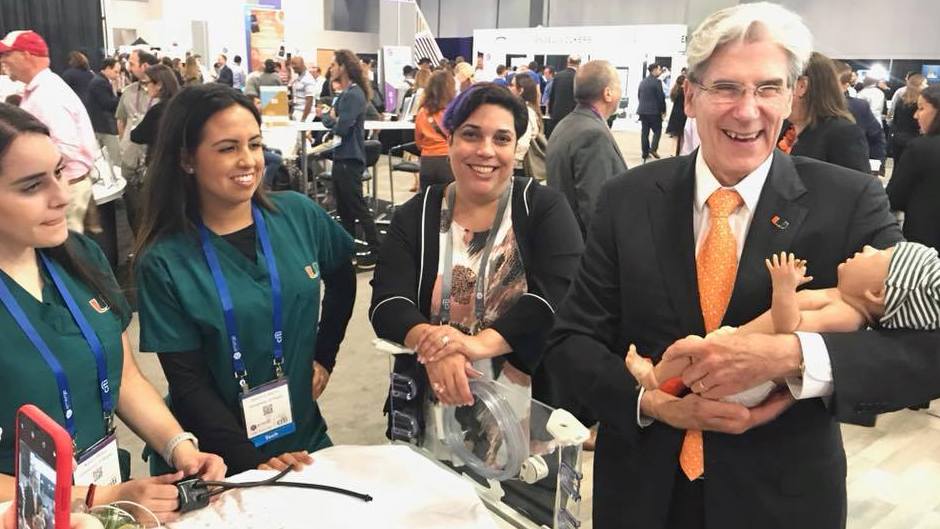From space helmet technology and drones to a lifelike infant simulator, the University of Miami was well represented by cutting-edge innovations at eMerge Americas 2018. The technology summit took place April 23-24 at the Miami Beach Convention Center, connecting innovators, investors and thought leaders through workshops, talks, networking and demonstrations.
The School of Nursing and Health Studies was front and center, with faculty and students showcasing the dramatic impact that the high-tech teaching tools from its Simulation Hospital are having on clinical training.
On day one, student Casey Pearce, B.S.N. ’18, introduced “baby Sebastian,” one of the hospital’s many patient simulators, to an enthralled group of high school students, media and other attendees. Baby Sebastian (also known as Super Tory in other scenarios) moved his arms and legs, blinked, cried, cooed, and exhibited a range of medical conditions, from respiratory distress to cardiac arrest.
“We can even change its color [to blue] and slow its heart rate and other vital signs,” explained Susana Barroso-Fernandez, Ph.D. ’16, assistant professor of clinical and director of simulation operations at the School.
As Pearce lifted Baby Sebastian, gently cradling his synthetic head, his mouth opened and closed and his arms waggled at his sides. His tiny chest rose and fell in simulated breaths. At one point, Pearce even began doing chest compressions with onlookers smiling with relief as the nearby cardiac monitor showed the simulator’s return to a normal rhythm.
“You can pretty much do anything you can with a normal newborn,” Pearce explained in a video produced by the Miami Herald. “You can assess them the same, you can feed them, you can do everything possible. You can also have complications … anything that could go wrong [in real life] can go wrong on him [Baby Sebastian]….”
“Students can learn from their mistakes without putting patients at risk,” said Barroso-Fernandez.
This past September, the SONHS opened its five-story, 41,000-square-foot Simulation Hospital, which replicates all aspects of a fully functioning healthcare system with features such as a home health care suite, operating rooms, a surgical and intensive care suite, and a neonatal intensive care unit for even the tiniest of patients, like Sebastian.
More than a thousand people die in the U.S. every day from medical errors, making it the third leading cause of death in the nation. “Simulation technology is designed to break that cycle,” said Barroso-Fernandez, a former pediatric intensive care nurse who practiced CPR on static mannequins, administered IVs on partial-task trainers, and injected oranges with hypodermic needles when she was a student nurse in training.
Today, simulation in the medical field is widespread. But it’s not the end-all for training technology. “Virtual reality is where we’re going next,” said Barroso-Fernandez. “We already have a space for it in the new Simulation Hospital.”
Such immersive learning is one of the best ways to acquire knowledge, UM President Julio Frenk said at the Future of Leadership and Fostering Entrepreneurship eMerge keynote on Monday. Noting the opening of the School of Nursing and Health Studies Simulation Hospital, he commented that “the future of Miami lies in innovation.”
Organizers estimate that over the two-day event, eMerge Americas, now in its fifth year, drew 15,000 attendees.
Adapted from https://news.miami.edu/stories/2018/04/um-technology-on-parade.html.
